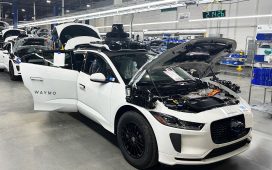ChatGPT ponders the pros and cons of letting artificial intelligence loose in the global supply chain
By Timothy Renshaw
|
April 26, 2023, 9:24am
Automation and artificial intelligence are coming soon to a cargo terminal near you. But where, when and to what degree remain fundamental challenges for the entire supply chain | Chung Chow
ChatGPT has nailed a few key points in the marriage of artificial intelligence and global goods movement.
That relationship might be in the honeymoon stage today, but marriage counselling looms large on the horizon.
Potential compatibility issues abound.
Goods movement players, especially international maritime shipping lines, are notoriously conservative and competitive. They also do not like to share, especially when it comes to data, and good data is now fundamental to good business operations. As in any successful marriage, sharing matters.
So, while AI intrusions into sharing accurate and timely data could improve supply chain efficiencies, they will not be welcomed with open arms.
That will require marriage counselling and other difficult conversations, because, as Chris Hall, president of the Shipping Federation of Canada, pointed out, “[AI] is arguably the most important tool that people are starting to use now. Every actor in the supply chain is adopting some form of AI or another – whether they’re shippers or carriers or logistics providers – terminals or ports. It’s everywhere now.”
OpenAI’s ChatGPT agrees.
Asked how AI will disrupt the global goods supply chain, ChatGPT opined that it “could be used to automate the documentation and tracking of goods, reducing the amount of time and paperwork needed to manage the supply chain.”
No disagreement with ChatGPT on that point. The supply chain needs all the help it can get with its paperwork quagmire.
Consider, for example, that each maritime shipment of cargo requires shippers to deal with more than 30 different documents, 250 copies and anywhere from 27 to 40 regulatory and business entities. That is the estimate WNS Global Services executive vice-president Jaison Augustine provided during a December panel discussion on modernizing supply chain workflows organized by S&P Global.
But ocean carriers and other links in the global logistics chain have neither the data system inter-operability nor the baseline of common standards upon which to streamline that process and reduce that paperwork.
As Hall pointed out, the shipping industry does not live on technology’s cutting edge.
“We’re not usually known as the disrupter or an early adopter on too many things,” he said, “and usually, for good reason. So, we tend to take it slow in this business and make sure that others test things out before we go too heavily into it.”
He pointed out, for example, that Canada remains far behind in getting on board with the International Maritime Organization’s Maritime Single Window system of port data sharing, which is scheduled to come into effect on Jan. 1, 2024.
So, more than AI-shipping marriage counselling will be needed there.
AI might have the answers to data sharing and incorporating digitization processes for ports and shipping companies, but it does not have the negotiating algorithms needed to persuade shipping’s major players to agree upon the right pieces to the puzzle.
At least, not yet.
In B.C., major maritime shipping companies are still pondering those pieces.
Methanex (TSX:MX), whose Waterfront Shipping subsidiary operates the world’s largest fleet of methanol-powered ships, declined to provide input for this story because, as it noted in an email response to BIV, “We haven’t completed formalizing our strategy on the use of AI and its impact on the shipping industry yet.”
For Seaspan Corp., incorporating AI into the operations of the world’s largest lessor of container ships has to make business sense, according to Torsten Pedersen, Seaspan’s chief operating officer.
He said the company is “AI enabling” its vessels’ connectivity and software so that Seaspan’s fleet will have the flexibility to deploy AI in the future.
“But the decision criteria will always be driven by business benefits. Can we make our operation more efficient and scalable, or can we add additional value to our customers? We are quite principled in making sure that we have a clear view of the benefits that we can derive before we start implementing new solutions.”
Pedersen added that AI could be used to improve shipping industry decision-making.
“Also, there will be opportunities to scale our operation and, possibly, fundamentally change the way shipping operates. Many talk about autonomous vessels driven by AI, but that is probably some years away. However, there could be intermediate steps where we could ease the workload and/or safety for the crews on board a vessel.”
In an interview earlier this year, Pedersen told BIV that the company will be harnessing data and digitization to “develop new insights into how we operate ships and new propositions towards our customers. And there are certainly opportunities to find new value propositions, new revenue models around digital solutions.”
Considering the size of Seaspan’s fleet, he pointed out that “even small improvements become bigger.”
But what about security, ChatGPT wants to know? It pointed out that “AI-based systems are vulnerable to cyberattacks and could be used to gain access to confidential information, disrupt supply chain operations or even cause physical damages.”
Good points.
Six years ago, one of the largest maritime container shipping companies in the world was hit with a cyberattack that crippled its booking system, stalled tracking of its containers and disrupted operations at container terminals all over the world operated by its APM Terminals subsidiary.
The financial cost to A.P. Møller-Mærsk (CPH:MAERSK-B) was later estimated at US$300 million.
Canada’s Minister of Transport Omar Alghabra shares ChatGPT’s AI concerns.
He told BIV during his April 13 visit to Metro Vancouver that, while AI is going to be part of the country’s economy, “and help us if done right,” he cautioned that “cybersecurity is a real threat.”
He added that “one of the lessons learned over the last couple of years from supply chain disruptions is that there isn’t enough information being shared across the sector. And we need to change that.”
Shipping lines are especially vulnerable to cyberattacks because of the wide range of entry points to their operating systems and their navigation and cargo technologies and the number of different connections needed to co-ordinate cargo movement.
ChatGPT therefore advises that more than information sharing is needed on this file. Its inventory of preventive measures ranges from educating employees and implementing response plans to limiting access to sensitive information and monitoring system network activity.
Digitization and AI can also open digital doors to tech-savvy thieves and organized crime rings.
As Keith Lewis, the vice-president of Verisk Analytic Inc.’s CargoNet crime prevention database, recently told BIV, “The bad guys are now using the internet to do what they used to do with a lead pipe and a gun. It’s easier, it’s faster, and they can do it more efficiently … they can steal more because they can do it with the click of a button versus having to go to a truck stop or a truck yard and steal freight.… The problem is the bad guys are playing chess and the good guys are playing checkers.”
The increased incorporation of automation and AI in ports, terminals and other key links in the global supply chain also threatens to disrupt labour pools and displace workers.
For example, the Vancouver Fraser Port Authority’s $3.5 billion Terminal 2 container cargo expansion project at Roberts Bank, which secured federal cabinet approval on April 20, will incorporate automation.
How much automation remains to be seen, and that has raised the concerns of International Longshore & Warehouse Union Canada, which is negotiating a new contract with B.C.’s maritime employers.
But ChatGPT remains optimistic about AI.
It wraps up its AI-in-transportation assessment with this observation: “AI has the potential to revolutionize container shipping and the global goods supply chain, making them more efficient and cost-effective.”
No definitive word, yet, on how to turn that potential into reality.
With any luck, ChatGPT 2.0 is working on it now.
trenshaw@biv.com
@timothyrenshaw









